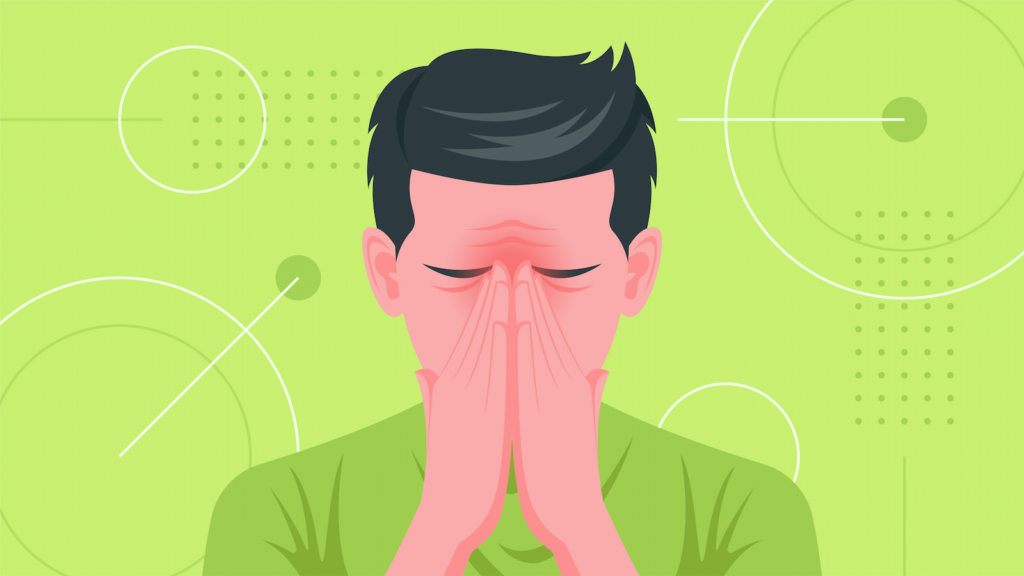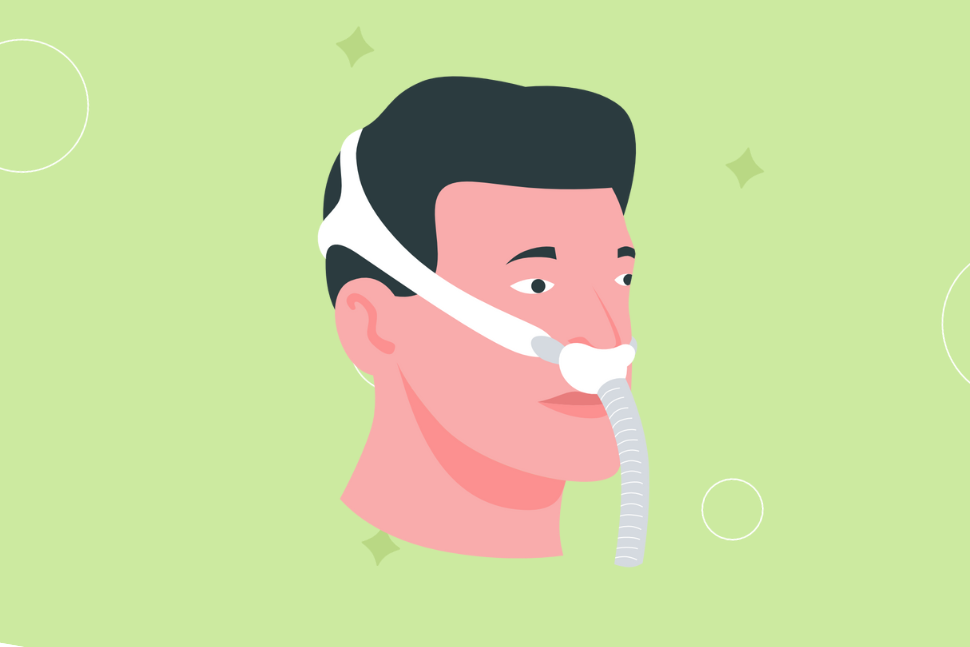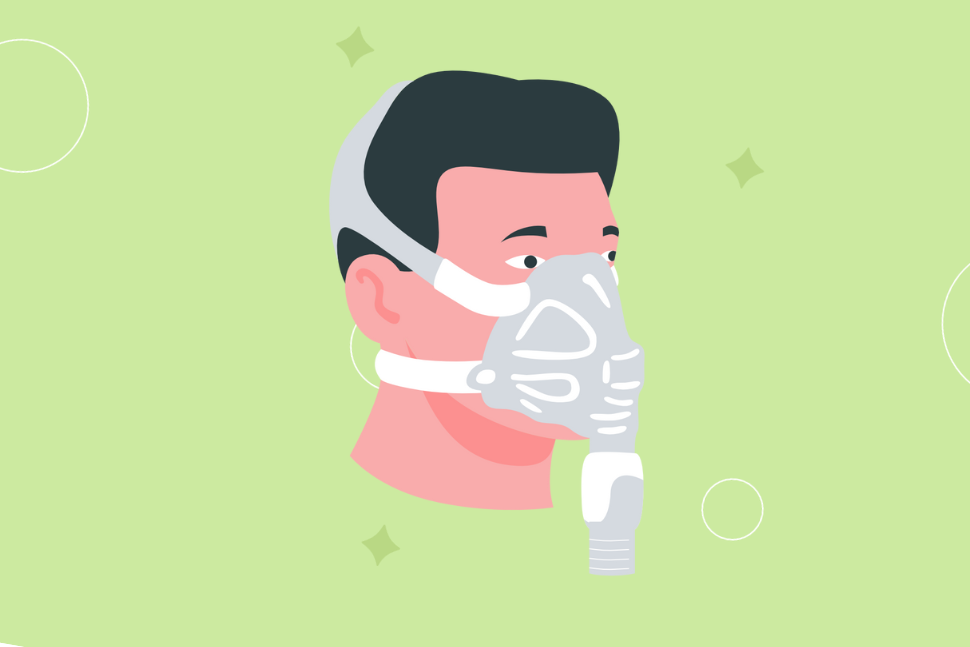Finding the best CPAP mask for side sleepers can be tricky. It’s like trying to navigate a maze.
There are so many options out there. Knowing which one will work well and feel good to use can be confusing.

However, this is essential for people who want to treat their condition successfully.
Choosing the right mask takes effort. But rest assured, if you know what to look for you can find a mask that works well for you as a side sleeper. Let’s explore the key things you should consider.
Challenges of Side Sleeping with CPAP Therapy
Using a CPAP machine while sleeping on your side can be tricky if you have obstructive sleep apnea (OSA).
Finding a comfortable mask is vital to using your CPAP therapy every night as your doctor prescribes. If the mask doesn’t feel good, you might stop using your CPAP machine too soon.
This means the treatment won’t work as well to help your OSA symptoms.
But, sleeping on your side can make finding the ideal CPAP mask harder because most regular masks are for back sleepers.
Masks that don’t fit right or slip around during sleep can let air escape. This can lead to nasal passages and eyes that feel very dry and irritated.

But if you over tighten your mask, you can develop red marks or sore spots on the skin over time.
Perhaps worst of all, big bulky masks can get in the way of your pillow, too.
So what can you do? It turns out there are a number of considerations that can drastically improve your comfort—and therefore your ability to acclimate to your new therapy therapy.
Choosing the Right CPAP Mask for Side Sleepers
Most CPAP masks will work well—after all they’re medical devices with endless research and development performed to make sure they do so.
So when it comes to picking the right CPAP mask or side sleepers, it’s mostly about comfort.
This is largely a personal preference, and might require a little testing to find the perfect option for you, but these considerations should help you limit your options to get to the right choice for you quickly and with minimal cost.
Why a Bendy Frame, Tubing Options, and Small Size Help Comfort
Simply put, a frame that can bend adapts better. This means that if you’re a side sleeper, a bendy frame can provide much-needed flexibility regardless of your mask size or cushion type.
Of course, a smaller size means less of the mask touches your face.
Both things are important for side sleepers who need to move around more.
Side sleepers often praise nasal pillow masks for being the perfect balance of both of these considerations. As such, they’re an excellent place to start your search for the perfect CPAP mask to use when sleeping on your side.
Better still, many popular nasal pillow and nasal mask options also feature designs that allow the tubing to connect at the top of your head instead of sticking out or down from your mouth.
This allows for greater flexibility in movement and reduces the chance of getting tangled in your tubing should you roll over or move around in your sleep.
Features & Suitability of Nasal Pillow Masks
Nasal pillow masks are a leading option due to their compact size and ideal positioning, but they’re not perfect for everyone.
Advantages of Using Nasal Pillow Masks
The small size of a nasal pillow mask is the key feature that differentiates this mask style from the rest. In most cases, these just barely cover the base of your nose—a huge difference from full face masks.
This smaller size means it gets in the way less while you sleep. But it also makes it easier to see when you’re awake as well.

You can do things like read or watch TV before bed without taking the mask off.
But most importantly, since nasal pillow masks seal right at your nose, they’re more likely to stay in place if you toss and turn in your sleep.
This keeps the air pressure steady even if you switch from side to side often during the night.
Limitations Associated with High-Pressure Settings
But nasal pillow masks aren’t always the best for every part of CPAP therapy. If your treatment needs high air pressure, these small masks might not be able to provide enough airflow or a strong enough seal.
If you’re on the edge of the pressure limit for your mask, it might also not stay in place as well or be more prone to leaks.
This means that while you might be able to lie down more easily with the mask on, that it might actually perform worse while you’re sleeping.
Since the air from these masks go directly into your nasal passages, stuffy sinuses and deviated septums can be another problem.
Any blockage from your physiology, environmental allergies, or colds will stop it from working right and can cause significant discomfort.
Fortunately, with the help of your doctor, you can likely find a solution that helps you make the most of your treatment if these issues are a concern.
NOTE: If you’re looking for a nasal pillow mask, be sure to check out our round up of top nasal pillow cpap masks for the best options available today.
Benefits & Drawbacks of Nasal Masks
Nasal masks are a popular choice for side sleepers using CPAP therapy who don’t like the nasal pillow masks.
These slightly larger masks often cover the nose instead of sealing against your nostrils.

This provides significant size savings over full face masks, while also coming with a few unique benefits over nasal pillow masks as well
Effectiveness at Higher Pressure Settings
Nasal masks work well at higher air pressure ratings than many nasal pillow mask options.
This makes them a great option for people who need more intense pressure during treatment but find that full face masks are not comfortable for sleeping—a common occurrence for people who sleep on their sides.
This provides good relief from obstructive sleep apnea (OSA) symptoms as long as you’re not typically a mouth breather—though in this case a chinstrap can often help.
Potential Downsides Due To Nasal Issues
Nasal masks might not work for everyone, even if they are comfortable and can handle high pressure.
For example, much like nasal pillow options, if you often have bad congestion, a deviated septum, or chronic nasal problems like allergies or colds, this could impede or completely block the airflow from your CPAP machine, making the treatment less effective.
Mayo Clinic suggests talking to your doctor about any existing health issues before choosing this type of mask for your CPAP therapy.
Finding The Right Fit For Comfort And Effectiveness
Since these feature more contact area than nasal pillow masks, dialing in the fit is even more important.
If it’s too tight, it might feel uncomfortable. If it’s too loose, it could leak leading to nasal soreness and reduced therapy effectiveness.
NOTE: Our round up of top nasal cpap masks for the best options on the market from leading manufacturers you can trust.
Other Suitable Mask Types For Side Sleepers
Sleeping on your side while using a CPAP machine can be challenging. But it’s not impossible. Nasal pillow masks and nasal masks are often the top picks for side sleepers.
However, other types of CPAP masks work just as well.
The Pros and Cons of Full-Face Masks for Side Sleepers
A full-face mask covers both your nose and mouth.
It’s good for people who breathe through their mouths while sleeping and find chinstraps uncomfortable as well as those with ongoing sinus problems or a deviated septum.
This mask style lets you breathe comfortably even if your nose gets stuffy at night.
But because it’s bigger than other mask types, some people might find it uncomfortable when sleeping on their side.

Besides feeling bulky, the mask could also irritate your skin over time. So, if you have sensitive skin or easily get allergies, keep this in mind before choosing a full-face mask.
NOTE: For a list of leading full-face CPAP mask options, be sure to consult our round-up.
Remember, everyone has different needs when picking the right CPAP therapy device.
Understanding each mask option’s pros and cons will help you make a smart choice that best suits your situation.
This will lead to better treatment results. Always check with a medical expert if you need help determining what works well for you.
FAQs Regarding Best CPAP Masks for Side Sleepers
Can you sleep on your side with a full face CPAP mask?
Yes, sleeping on your side with a full face mask is possible. But keep in mind that these masks are bigger than other types. This might make them less comfortable when you’re lying on your side. Some people find that the bulk of the mask pushes against their face in this position.
Keeping a good seal against your skin can also be more challenging. If you move around a lot, the mask might shift and let air escape.
What CPAP mask leaks the least?
The amount of leaking depends more on how well the mask fits than its type. In general, nasal pillow masks and masks can provide a good seal, but everyone’s experience is different.
The key is to make sure your mask is the right size and shape for your face. It should feel snug but not too tight.
If you’re having trouble with leaks, talk to your doctor or CPAP supplier. They can help you find a mask that works better for you.
How do I know which CPAP mask is right for me?
To choose the best CPAP mask, think about:
- Your sleeping position (side, back, or stomach)
- How you breathe (through your mouth or nose)
- The air pressure settings you need
- Any breathing problems you have (like allergies or a deviated septum)
Try on different types of masks if you can.
See which one feels the most comfortable and natural to wear. Feel free to experiment until you find the perfect fit.
You can also check our guide on the best CPAP mask types for every type of sleeper for further information tailored to how you prefer to sleep.
Can I use a regular pillow with a CPAP mask as a side sleeper?
While you can use a regular pillow, many side sleepers find that a CPAP pillow works better.
These specialized pillows have cutouts or curves that provide space for your mask and hose, reducing the risk of dislodging your mask or putting uncomfortable pressure on your face during the night.
What should I do if I experience skin irritation from my CPAP mask?
If you develop skin irritation, first ensure your mask is clean and fits properly without being too tight.
You can also try using a barrier cream, face moisturizer, or mask liner designed for use with CPAP masks.
If irritation persists, consider trying a mask with a different cushion material (like gel or cloth) or consult your doctor or CPAP supplier.
For more information, be sure to consult our guide on preventing CPAP mask sores and our CPAP machine use essentials guide.
Can I wear glasses while using a nasal pillow or nasal CPAP mask?
Yes, most nasal pillow and nasal masks are designed to work well with glasses. The smaller profile of these masks leaves more room for glasses than full face masks.
However, you may need to adjust your glasses or look for a pair with thinner temples to ensure a comfortable fit with your mask.
I toss and turn a lot during the night. What’s the best mask for active sleepers?
For active sleepers who change positions often, a nasal pillow mask is usually the best choice.
These compact masks have a minimal contact area and a flexible hose connection, allowing the mask to move with you without losing its seal or getting dislodged.
Some nasal and full face masks also have special features like swivel joints to accommodate movement during sleep.
For more information comparing the various mask designs available, be sure to read our guide on the best cpap masks for every type of sleeper.
Conclusion
Congratulations! You’ve made it through the maze of finding the best CPAP masks for side sleepers.
By now, you understand that comfort and how well the mask works are important when choosing a mask.
Nasal pillow masks and nasal masks are often the top picks for people who sleep on their side.
But remember, your own likes matter too! There is no one perfect answer for everyone.
High-pressure settings or ongoing nasal problems can change what works best, and full-face or oral masks might do the trick when others don’t fit right.

Getting used to your new treatment takes time. But if you’re patient and keep trying, it will get easier.
With equipment that fits well and regular care, you’ll your way before you know it!
If you or someone you care about has sleep apnea, CPAP Supply has the answer.
We offer a selection of top-rated CPAP machines that give an effective and affordable way to treat this common problem.
With our high-quality products and expert customer service, we can help make your life better with a therapy system made just for your needs.
Don’t wait any longer – take charge of your health today by getting the relief you deserve!
References
- Reddit: Side Sleepers What Mask Do You Recommend?
- CPAPTalk: Best Masks for Side Sleeping
- SleepApnea.org: How to Choose a CPAP Mask Based On Your Sleep Position
- Sleep Foundation: How to Choose a CPAP Mask Based On Your Sleep Position
- TalkAbout Sleep: Best CPAP Masks for Side Sleepers: No More Troubles at Night
